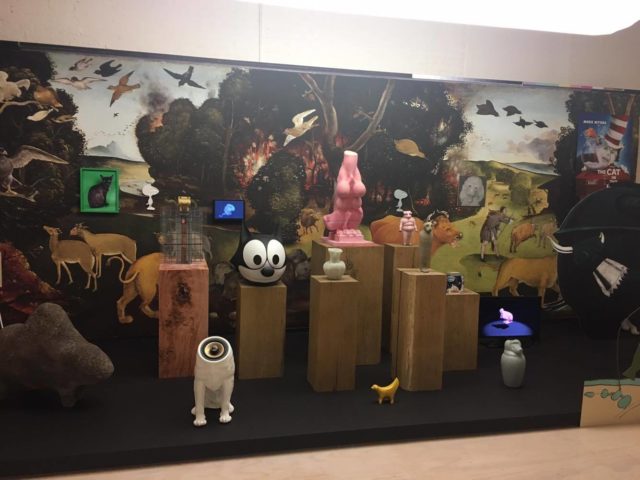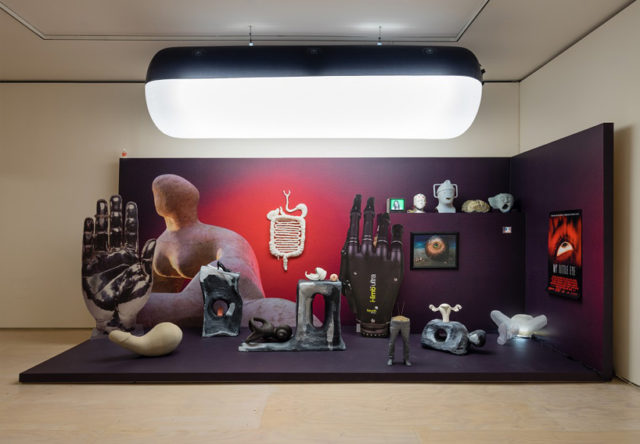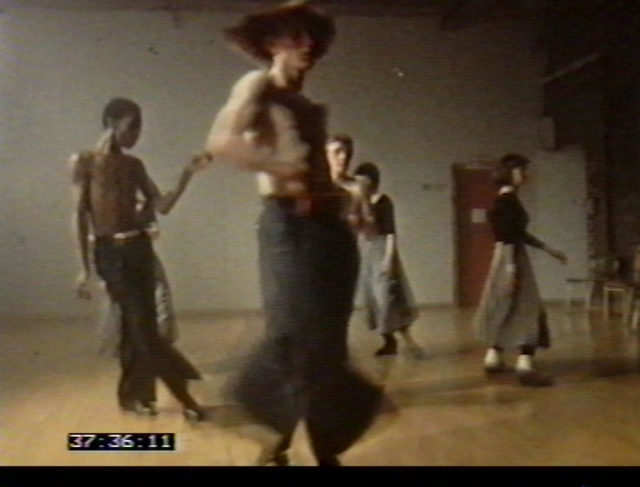
Mark Leckey, UniAddDumThs (Animal), 2013-2016 (photo by author)
Mark Leckey: Containers and their Drivers
MoMA PS1
22-25 Jackson Avenue
Queens, NY
On view until March 5, 2017
It’s hard not to see any art through the lens of politics this week. Trump’s unexpected victory leaves little space for anything else–nearly any experience has a surreal quality to it.
I’m not going to say I don’t find this disruptive to the critical process. The context of evaluating art has changed. What was relevant seems useless post-Trump. But since there’s no way around it, I’ve decided to embrace it. In the case of Mark Leckey’s Containers and Their Drivers at MoMA PS1, I found his career-long satirical engagement with technology amusing on Monday. Today, though, three days after the American people decided to press the country’s self-destruct button, I’m left wondering if the show even weathered this sudden change in perspective.
Containers and Their Drivers features brightly colored and monumental installations that proliferate through two floors of the museum. In one room, a talking “smart” Samsung refrigerator stands in a green screen set while a Samsung TV plays the resulting film. A huge reproduction of a highway overpass, where Leckey used to frequent, covers an entire section of another gallery. In yet another room, an inflatable but slightly deflated Felix the Cat slumps in a corner behind an offering of booze, money and a single rose.

Installation view of Mark Leckey’s Felix the Cat (photo by author)
This is not the only time Felix appears and reappears in the exhibition. His image is peppered throughout MoMA PS1. It’s not only maddening and destabilizing, but it’s also representative of the unending digital copy. Everywhere viewers turn, Felix is likely there. It feels like a funhouse version of Walter Benjamin’s The Work Of Art In The Age Of Mechanical Reproduction.
This isn’t just my own self-indulgent academic reference. There is a dry and slightly nerdy academic and art-related humor that runs through the entire show. Viewers won’t fall on the floor laughing or even, laugh out loud. But, I did crack a couple wry grins at installations like UniAddDumThs, in which he arranges and categorizes scanned and copied reproductions of the artworks he included in a group exhibition The Universal Addressibility of Dumb Things. He based the show on a file of images he saved on his hard drive. Dividing the works into sections like “animal,” “man,” and “machine,” it’s amusing to see Herman Makkink’s Rocking Machine–better known as the deadly penis sculpture in Stanley Kubrick’s A Clockwork Orange–treated as if it’s in a crowded history museum diorama.

Installation view of Mark Leckey’s UniAddDumThs (Man) in Containers and Their Drivers (photo by Pablo Enriquez; Courtesy the artist and MoMA PS1)
Granted, this humor didn’t always land. Even on Monday, I didn’t quite get his deadpan series of faux lectures like The Long Tail, inspired by (of course) Felix The Cat, shown in smaller rooms on the museum’s second floor. But, today I’m not laughing at all. I just can’t muster the same enthusiasm for Leckey’s cheeky categorization of art as “dumb things,” while watching the dumbest–and most dangerous–things playing out on a national scale. And most of the work feels, in retrospect, similarly irrelevant.
The one bright spot in the exhibition that took on unexpected political meaning in the context of the election was Leckey’s first breakthrough video Fiorucci Made Me Hardcore. It captures the progression of Britain’s club culture from the 1970s until the 1990s and its creation of a de facto community of dancing bodies, which gave me a glimmer of hope in the darkness of Trump’s America. And with dual gargantuan speakers that are built to look like the ones Richard Long made for Studio 54, the loud, trance-inducing sound of that legendary disco provides some much-needed escapism.

Mark Leckey, Fiorucci Made Me Hardcore. 1999. Still from video. TRT: 15 minutes. Image courtesy Mark Leckey and Gavin Brown’s enterprise, New York/Rome. © Mark Leckey.
Made over the course of four years, Leckey painstakingly spliced together found footage of dance clubs–a difficult task pre-YouTube. The video jolts, stops, starts, zooms and pauses around the faces of young dancers, groups of men walking through industrial streets and seemingly random shots of fashion brands. At first viewing, the piece is hilarious. This is largely due to the dorky disco dancing from the earliest videos in the work, as well as the goofy drugged-up behavior of the ecstasy-riddled ravers of the 1990s. Take, for example, one memorable wide-eyed woman who fixates on a ribbon that is tied around her wrist. To a sober art viewer, most of the dancers are, kind of embarrassing.
After a second viewing of the almost fifteen minute video, Fiorucci Made Me Hardcore gains a deeper meaning and even, a subtle political relevancy. By tracing this legacy of transformative nightlife, Leckey breaks down the barriers of generations and musical genres. At some point in the video, it becomes difficult to tell one era from the other, developing into a more expansive documentation of the collective human impulse to gather, celebrate and dance. With occasional glitch-filled shots of a cloudy sky, the video references the transcendence that occurs within these specific niche subcultures.
And there is also a political message here, albeit an underlying one. Margaret Thatcher acted as Prime Minister through much of the time depicted in the video. This era consisted largely of conservatism and tension, particularly around Northern Ireland, the Cold War and HIV/AIDS. The landscape depicted in the video looks bleak and depressing while in the clubs, it seems vibrant and exuberant. There’s a palpable sense of passion in the video that is as infectious to the viewer as it is visible, which might explain why I find it so compelling in my post-election stupor. This sense of freedom and community-building, as depicted within the club culture in Fiorucci Made Me Hardcore, might be just what is needed looking ahead to Trump’s administration.


Comments on this entry are closed.